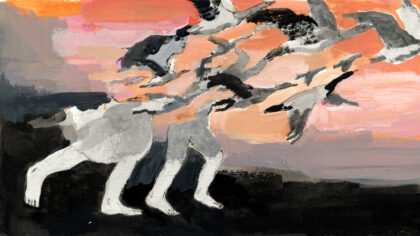
I take the public bus with my child, M, just about every day. She is 13 years old and she is good at riding the bus. She is also good at identifying the security cameras on a bus. Finding them is like a game.
A screen located near the front of the bus, behind the driver, rotates through live closed circuit TV footage. One camera pointed at the driver shows them from above, turning the huge steering wheel. A second later, it switches to video of passengers in the back of the bus. Then to the middle. And then to us. When the video of us rotates through the screen, M waves at the camera.
M points to a notice among the ads above the bus windows. “Download the new ‘See, Say’ app!” The smart phone application, which is branded with Transit Police, is marketed as something to give riders “a discreet way to report suspicious activity.” We note the new ways the police are inventing for people to spy on each other.
As someone born almost ten years after the 9/11 attacks, M has grown up in a world with this kind of mundane surveillance. She cannot remember a city bus ride without closed circuit cameras. Their presence is not alarming, or even curious, but normal (if obnoxious). They are among the countless surveillance cameras that she encounters in the course of her day, including those installed by homeowners toward the streets in front of their residences. When we ring up our groceries, she waves at the camera, watching her own image waving back at herself from the screen at the self-checkout station.
The omnipresent watchful cameras that M and I encounter are just one way that the notion of “security” has become normalized as currency in policymaking and in our day to day lives. But with all this watching and being watched, are we actually safer? Do we even feel safer? Who and what are we being made safe from?
It is worth remembering that today’s enemies – Washington, Moscow, and Beijing – were allies in recent memory, united by the War on Terror, an ideological framework that would normalize the apparatus of war in our daily lives and enshrine a militarized version of “security” as a currency to mediate our most basic, day to day social interactions. The now-widely accepted practice of surveillance, which fosters the paranoia that anyone can be a threat, is just one expression of it. In the US, the greatest challenge to the reign of security rooted in counterterrorist discourse would come from the “racial reckoning” that has mobilized millions across the nation over the past few years.
We note the new ways the police are inventing for people to spy on each other.
After the attacks on the World Trade Center and the Pentagon on September 11, 2001, Vladimir Putin was the first head of state to call president George W. Bush to extend his personal condolences. Russia offered intelligence sharing and other assistance, but Putin’s generosity was not guided by altruism. At the time, Russia was waging the Second Chechen War, which massacred Chechan civilians and infamously devastated Chechnya’s capital, Grozny. Washington’s condemnation of this war faded as Russia and the US found common ground. Indeed, the US would partner with Afghanistan’s Northern Alliance, of which Russia was a patron and key weapons supplier, to carry out its 2001 invasion of the country.
That same common ground softened tensions between Washington and Beijing after the Hainan Island Incident of April 2011, during which a US spy plane conducting surveillance off the coast of China collided with Chinese fighter jets. Subsequently, Beijing, with Washington’s blessing, set in motion the massive surveillance and repressive apparatus in Xinjiang against Uyghurs and other Muslim ethnic groups that US officials decry today.
Of even greater significance, however, is the sheer breadth of states for which the “War on Terror” has become a useful framework. By labeling “terrorist” any act, symbol, or individual member of a group that they are targeting, policymakers can circumvent grappling with the circumstances that produce political violence by non-state actors. States also use the “terrorist” label to discredit movements. Israel, for instance, is criminalizing the act of flying the Palestinian flag because displaying it, according to its national security minister Itmar Ben Gvir, is equal to “identification with terrorism.” “Fighting terrorism” has also been deployed by multiple regimes across the world – including France, India, Pakistan, Nigeria, Kenya, the United Kingdom, Turkey, Canada, Syria, and Indonesia – to justify significant military and surveillance operations.
“Fighting terrorism” alone, however, cannot sustain the sweeping and extreme militarization the US has pursued over the past twenty years at every level of social and political life, particularly in its domestic sphere. This includes the fortification of borders and regulation of people’s movement using new police forces and biometrics; the procurement of heavier, military grade weapons, vehicles, and training in war tactics for local police departments; and a level of technological surveillance that was unimaginable just a generation ago. Enter the even vaguer notion of “security.”
By labeling “terrorist” any act, symbol, or individual member of a group that they are targeting, policymakers can circumvent grappling with the circumstances that produce political violence by non-state actors.
“Security” was the justification for a new set of policing agencies and a raft of legislation, such as the USA PATRIOT ACT, that restricted civil liberties. It is also the rationale for the violation of existing law by Border Patrol, Customs and Border Protection, and other agencies under the Department of Homeland Security. Refugees, asylum seekers, and other migrants at the US-Mexico border, historically framed as potential thieves of “American” jobs, are now threats to “Homeland Security,” who must navigate whatever obstacles are imposed by the twenty-year-old department bearing that name, even when they contradict other established legal norms. Trump’s – and now Biden’s – policies that force asylum seekers to stay in Mexico indefinitely are violations of US and international law, which state that people seeking asylum have the right to enter the country and pursue the process here.
As currency, “security” allows authorities to justify countless activities on their part and enact endless requirements for compliant behaviors on ours, like removing our shoes and jackets when traveling through US airports. Like money, “security” both functions as a means to facilitate interactions between different parties by establishing a shared system of value, and as an end in and of itself as parties are incentivized to accumulate more and more of it. “Security,” however, also offers a pretext flexible enough to cast any number of problems as “threats,” and respond to them with surveillance and violence. Crucially, while “fighting terrorism” remains the purview of governments, “security” invites the participation of ordinary citizens.
Indeed, perhaps the ultimate test of a currency’s value is the extent to which it is embraced by the general population. In monetary terms, the global home security system market, made up of consumers who purchase cameras and other surveillance equipment for their personal, domestic use, was valued at $51 billion in 2021 and projected to hit $106.3 billion by 2030.
I came into my adolescence in the late 1990s. In contrast to my daughter’s daily experience, the surveillance that I experienced as a young, Black kid was far more analog. Surveillance cameras were relatively scarce, but plenty of white adults physically approached me, demanding to know what I was doing in their neighborhoods when I rode my bike through them.
When it came to my safety, my parents taught me to be cautious among white folks and especially, to beware of the police. It soon became clear to me why through my own experience. Earning my driver’s license brought me a new level of mobility, but I also entered a new world of policing. The dozens of times I was stopped by the police, including being surrounded by them, surely influenced my decision to forego owning a car in my adulthood (hence all of our time spent on public transit).
In the late 1990s conversation about rampant, racist police violence was on the rise. There were stories of cruelty by police in Chicago, Philadelphia, the Bay Area, and Los Angeles, where memories of the beating of Rodney King and its aftermath were fresh. In the small city where I grew up, I witnessed police beatings on the street and met Black men who were victims of their brutality. But the most notorious police department was the NYPD.
The dozens of times I was stopped by the police, including being surrounded by them, surely influenced my decision to forego owning a car in my adulthood.
Few figures advanced the notion that heavy handed policing was the key to security more than Rudolph Guiliani, who was mayor of New York City before his Trump administration fame. Black New Yorkers paid the price. In 1997, police in Brooklyn arrested and tortured a Haitian man named Abner Louima. In 1999, police in The Bronx killed Amadou Diallo at the doorstep of his apartment building in a hail of 41 bullets. In 2000, undercover NYPD officers killed Patrick Dorismond. All three Black men were unarmed.
When four police officers were charged with the killing of Diallo, a judge ruled that they could not get a fair trial in New York City, and the proceedings were moved to my hometown of Albany, New York. Among the first protests that I attended were those downtown outside of the courthouse. The cops were acquitted of all charges.
But the incident, and the other acts of police murder and other violence, were not without responses. Thousands marched in New York City when Diallo’s killers were acquitted. Even the conversation about mass incarceration and abolition was growing in the late 1990s. The year 1998 saw the first conference of the abolitionist organization Critical Resistance, which was founded by Angela Davis, Ruth Wilson Gilmore, and Rose Braz. The gathering brought together more than 3,000 people.
This mass interrogation of anti-Black racism, particularly as it manifests in the criminal legal system, was abruptly severed by the Bush administration’s response to 9/11. Giuliani went from being mocked as a fascist on late night television to being celebrated as a national hero.
Because of the enormous expansion of policing through the War on Terror, my daughter is growing up in a world with surveillance that is ubiquitous in ways that were technologically and politically impossible before the War began. But she is also growing up in a world shaped by the movement for Black lives and its titanic mobilizations, especially in the summer of 2020.
Their roots extend to nearly a decade prior, in the relatively small protests in response to the murder of thirteen-year-old Trayvon Martin, as well as the larger protests the following year when his white supremacist killer was acquitted in 2013. The following year saw the police murders of twelve-year-old Tamir Rice, Eric Garner, and Michael Brown, which was met by the Ferguson Uprising and a wave of Black Lives Matter protests. The year after that, Sandra Bland died in Texas police custody, and cops in Baltimore murdered Freddie Gray, sparking an uprising in that city.
Because of the enormous expansion of policing through the War on Terror, my daughter is growing up in a world with surveillance that is ubiquitous in ways that were technologically and politically impossible before the War began.
The explosive uprisings after the police killings of George Floyd and Breonna Taylor were a culmination of years of organizing that have deeply disrupted accepted logics of policing and surveillance. Though police violence did not stop – indeed, protesters were subject to severe repression in cities across the country – these acts of brutality and the police as an institution have been treated with a new level of scrutiny. Where legal processes had largely failed to hold the police accountable, social media became an arena for mass critical conversation, fueled by hashtags and cell phone footage documenting police abuses, while the protests themselves became public fora for confronting the actions of the police and discussing far-reaching solutions. In Minneapolis, where police murdered George Floyd, thousands gathered at mass meetings in June of 2020, debating whether the city’s police department should be abolished altogether.
The impact has been lasting. Police and prison abolition, concepts that had been confined to radical circles for years, were catapulted into the mainstream by institutions like the New York Times. These discussions have exposed the roots of US policing in slavery, as well as incited the reframing of racist policing as a public health crisis. Large numbers of police have quit the force, practically undermining the basis for police violence. Arguably, I think that these protests did what the past couple of decades of the War on Terror could not — and never meant to do – they actually made us safer, and in ways that only popular mobilization can.
The “racial reckoning” that has been unfolding over the past three years has posed the single greatest challenge to security as accepted political currency since 9/11. But it was already on track to happen more than two decades ago. While the primary targets of War on Terror were Middle Eastern, South Asian, and African Muslims, both in those regions and domestically in the US, the post 9/11 security regime went hand in hand with a devastating postponement of a Black, anti-racist critique of the police. This is one reason why the freedom struggles of Black and brown people in the US and abroad are inextricably intertwined.
It may be as difficult to imagine a world without “security” as without the dollar, or the euro. But the euro is only twenty four years old, just a couple of years older than the War on Terror. We witness currencies lose their value all the time, and multiple currencies have collapsed in our lifetimes. This all begins with an erosion of confidence. A money currency is only as valuable as its users’ ability to actually access the things it uses the currency to pay for. When the various forces involved – banks, governments, the vast body of currency users themselves – lose confidence in it, the currency unravels.
While the primary targets of War on Terror were Middle Eastern, South Asian, and African Muslims, both in those regions and domestically in the US, the post 9/11 security regime went hand in hand with a devastating postponement of a Black, anti-racist critique of the police.
In 2021, US forces withdrew from Afghanistan in a way that, by the State Department’s own admission, “failed to take into account key facts on the ground.” During the withdrawal, the US’ killing of multiple Afghan civilians by drone strike, the loss of thirteen US troops and more than 150 Afghans in an ISIS attack, the immediate collapse of the regime that the US had spent two decades cultivating, and the Taliban’s stepping into power all but indicted twenty years of US occupation.
Imagine where we might be now had these conversations taken place in the early 2000s instead of the 2020s. How might our lives be different? How many lives could have been saved?
There are many questions worth asking, upon reflection. But there are many more to ask urgently, as we look forward. Crucially, after two decades of normalized surveillance and militarization, what could the next twenty years of anti-racist solidarity look like? In a world where the state’s notion of “security” reigns supreme, for now, we are called to pull that regime’s threads, hasten its unraveling, and imagine a world on the other side of it.

